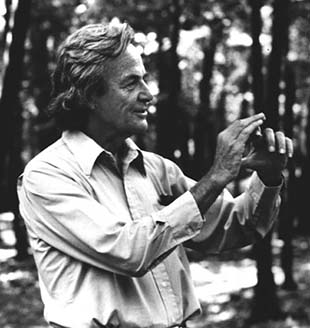

Richard Feynman (1918-1988)
“I can live with doubt and uncertainty. I think it's much more interesting to live not knowing than to have answers which might be wrong.”
–Richard Feynman
National Medal of Science recipient in 1979 “in recognition of his essential contributions to the quantum theory of radiation and to his illumination of behavior of constituents of the atom, of the atomic nucleus and of the subnuclear particles.”
Richard Feynman was born in Far Rockaway, Queens, N.Y. He often credited his father, Melville, with developing his sense of curiosity and his mother, Lucille, with instilling in him a sense of humor. As a child, Feynman enjoyed introducing scientific concepts to his younger sister, Joan, who grew up to be a distinguished physicist in her own right.
After excelling in mathematics as a student at Far Rockaway High School, Feynman earned his bachelor’s degree in 1939 from the Massachusetts Institute of Technology and his Ph.D. from Princeton University three years later. While at Princeton, Feynman was recruited for the theoretical division of the Manhattan Project, the secret U.S. Army laboratory set up in Los Alamos, N.M., for the purpose of developing the atomic bomb.
Feynman was present at the first detonation of an atomic bomb. The achievement excited him at first, but he ultimately expressed concerns about the implications of the technology. Feynman later developed safer methods for storing radioactive waste, an innovation responsible for saving the lives of many power plant workers.
While Feynman was at Los Alamos, his wife, Arline Greenbaum, who had suffered health problems throughout their marriage, passed away at the age of 25. Later that year, Feynman accepted a position teaching theoretical physics at Cornell University; he then joined the faculty at the California Institute of Technology (CalTech) five years later, in 1950.
Feynman is best known in the scientific community for his groundbreaking research on quantum electrodynamics, the theory that describes the interaction between light and matter. The pictorial representations that Feynman used to depict particle interactions have come to be known as “Feynman diagrams,” which are drawn according to “Feynman rules.”
For his work in quantum electrodynamics, Feynman received the Nobel Prize in physics, which he shared with Sin-Itiro Tomonaga and Julian Scwhinger. The general public received greater exposure to Feynman upon his appointment to the presidential commission that investigated the Challenger explosion in 1986. With a demonstration using a glass of ice water, Feynman revealed the vulnerability of the rocket booster’s O ring seal when exposed to cold temperatures.
Feynman remained active as a lecturer and researcher until the end of his life. He offered popular undergraduate physics courses at Caltech and was well-known by the student body, often attending freshman orientation. Feynman pursued a hobby playing bongo drums since his time at Los Alamos, and recorded an audiotape called “Safecracker Suite” of his drumming interspersed with personal stories. Several of Feynman’s lecture series were published to great public reception, and his 1985 memoirs--“Surely You’re Joking, Mr. Feynman!”--became a best-seller.
Feynman passed away from cancer in 1988, survived by his wife Gweneth Howarth, whom he married in 1960, and their two children. Feynman’s New York Times obituary described him as “arguably the most brilliant, iconoclastic and influential of the postwar generation of theoretical physicists.”
Image descriptions and credits
Any opinions, findings, conclusions or recommendations presented in this material are only those of the presenter grantee/researcher, author, or
agency employee; and do not necessarily reflect the views of the National Science Foundation.


